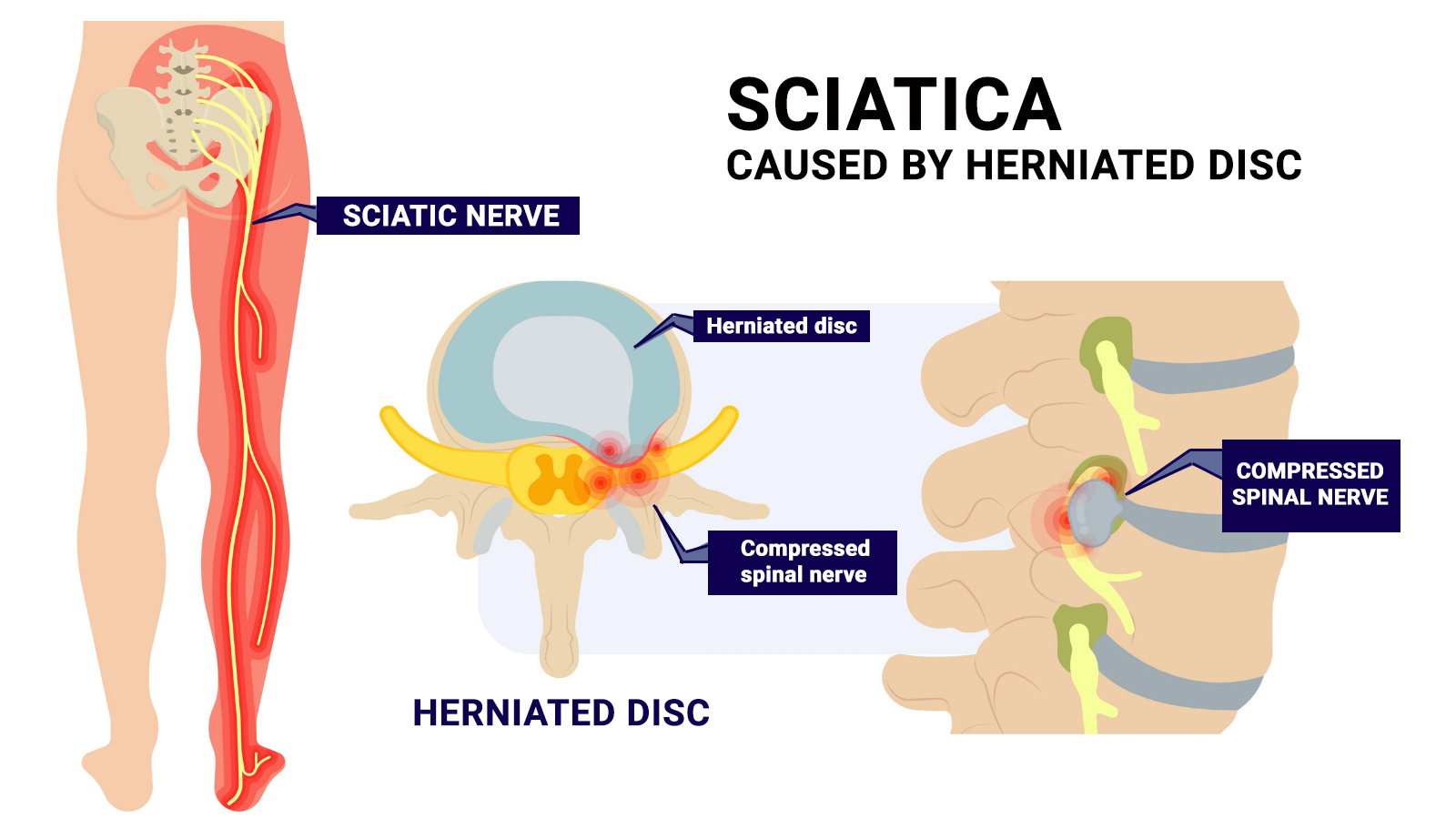Physical therapy for sciatica is an effective and safe way to pain-free life. Physical Therapsts NYC team of othropedic experts will provide you with an accurate treatment to help you relieve pain and improve you range of motion. You’ll work with experienced therapists using the latest technologies and newest equipment for physical therapy.
What is Sciatica?
Sciatica is a common type of pain, which affects the sciatic nerve. The sciatic nerve is a large nerve, which extends from the lower back and down to the back of each leg. It is the longest nerve in the body and is considered to be one of the most important ones. It can affect the ability to control and feel the legs. In cases where this nerve is irritated, individuals suffer from sciatica.
What Are the Symptoms of Sciatica?
Sciatica pain comes from a nerve that runs down your lower back, through your buttocks, and into your thigh and leg. For some, instances of sciatica are short and intense, others feel this pain on a more chronic or long-term basis. Some of the symptoms of sciatica include:
- Shooting pain from your back down your leg
- Stabbing feeling that makes walking difficult
- Numbness, tingling, or muscle weakness in one leg
- Bowel or bladder changes
- Radiating pain that comes in waves
- A feeling like a jolt or electric shock in your back
- Reduced mobility or difficulty walking
- Muscle spasms in your low back and lower extremities
All of these symptoms could be caused by sciatic nerve pain. The good news is that sciatica physical therapy can provide effective treatment for your symptoms and the underlying nerve problem. Our award-winning therapy staff uses state-of-the-art equipment, a hands-on approach, and modern techniques to help you find relief for your sciatic nerve pain. We are the best physical therapy clinic in NYC and we’re ready to show you why.
Read more: That Hip Pain Could Actually Be a Sciatica Problem

Causes of Sciatica
Sciatica is caused by an irritation of the root of the lower lumbar and lumbosacral spine.
Some other causes of sciatica include:
- Pregnancy
- Muscle spasms in the back or buttocks
- Lumbar spinal stenosis
- Spondylolisthesis
- Degenerative disk disease
Risk Factors for Sciatica
There are some behaviors or certain factors which might increase the risk of developing sciatica.
Some of the most common factors for sciatica include:
-
Age
- Working certain jobs that might put a strain on the back
- Suffering from diabetes or smoking
- Being overweight
- Not exercising regularly
- Wearing high heels
- Sleeping on a mattress that is either too soft or too hard
Age increases the possibility of suffering from wear and tear, diabetes increases the risk of suffering from nerve damage, whereas smoking can lead to the outer layer of the spinal disks breaking down.
Customized Physical Therapy Treatment For Sciatica
One of the most important things a physical therapist can do to help relieve your sciatic pain is listen. You are a unique person and we know that developing an effective physical therapy treatment plan for sciatica means we have to get to know you. It’s not just about knowing your pain symptoms, we also want to know your activity level, what you’re willing to do and what you can do. We will work with you to create a treatment plan that you’re willing to do and so we can help you be as successful as possible. At Downtown Physical Therapist NYC, we partner with you to turn our state-of-the-art facility into your healthcare oasis. We make your health our priority.
Great visit. Focused on whole body. Gave great home therapy options.
LDAmazing, very professional as well as efficient. The wait was very little, got to see the Dr. before my time.
MBChoose Downtown Physical Therapist NYC for Sciatica Pain Relief
Sciatic nerve pain is different for each person. You may even experience different symptoms from one bout of nerve pain to the next. This means that sciatic concerns can be hard to diagnose without a trip to a healthcare specialist. If you believe your pain is related to your sciatic nerve, schedule a consultation with our clinic and we’ll help you discover the cause of your pain and start an effective treatment plan. We have many different approaches and by combining therapy techniques, we will find a way to improve your comfort and function levels.
Sciatica Facts
- Sciatica is one of the most common, but yet misunderstood, types of nerve pain. Nearly 40% of people will get it during their lifetime. Older people has a higher risk of sciatica.
- Mild sciatica often resolves with time and at-home treatments. Beetween 80% to 90% of sciatica sufferers get relief with non-surgical therapies. These include physical activity, physical therapy, and stretching.
- Most people with acute sciatica have a good prognosis but nearly 20%-30% have persisting problems after one or two years.
- Taller people, smokers, and those with mental issues tend to be more prone to sciatic pain.
References
- https://www.health.harvard.edu/pain/sciatica-of-all-the-nerve
- https://my.clevelandclinic.org/health/diseases/12792-sciatica
- https://www.ncbi.nlm.nih.gov/pmc/articles/PMC1895638/
Physical Therapy for Sciatica
Physical therapy is often a large part of any successful treatment plan for back pain and sciatica is a classic example of common back pain. Your therapist, a sciatica pain specialist, will help you improve strength and overall fitness in your back and surrounding muscles by using exercise and movement techniques. Over time, you’ll see an increase in strength and flexibility that will relieve your pain entirely or alleviate it enough for you to continue daily activities. You’re encouraged to continue exercise and therapy on your own to keep your back in shape and prevent future injuries or pain.
Downtown Manhattan and Brooklyn physical therapists are experts in the treatment of sciatica. Our licensed PTs can help patients alleviate their sciatica symptoms with the newest treatment programs, including occupational stretches, manual therapy, and pain relief techniques.
“Sciatica epitomizes the profound interplay between our neurological framework and bodily mechanics. It serves as a poignant reminder to approach our physicality with reverence and attentiveness, acknowledging the delicate harmony between nerve function and movement.” – Dr. Hetarth Kapadia
Occupational Therapy for Sciatic Pain
Occupational therapy will help you stay independent in your home and your regular life. The goal is to learn new ways to move that avoid putting additional strain on your sciatic nerve and you back in general. Assistive tools and devices are often used in the course of occupational therapy for long-term success in managing chronic conditions.
Manual Therapy to Relieve Sciatic Nerve Pain
A hands-on approach to sciatic nerve treatment will often include manual therapy. This type of therapy can include body manipulation, exercise, and massage. The first step is to relieve as much pain as possible, so your symptoms are tolerable, and then work on strengthening and rebuilding muscle and flexibility.
Our Physical Therapists NYC
Our patients travel from all over New York City to visit our state-of-the-art pain relief center because they know that we understand the recovery process from A to Z. Our equipment and pain management techniques are totally holistic and patient-centered. We know and understand the difficult process after an accident and this is why we have helped countless from our area.

Dr. Hetarth Kapadia, PT
Physical Therapist
“My knee pain is Feeling way better thanks to PT. Dr. Kapadia made my situation Feel so simple! I’ll be back!”

Enrica Sosa, NCBTMB
Physical Therapist
“Enrica Sosa is amazing! Extremely knowledgeable and attentive to your pain and recovery. Highly recommend!”

Dr. Nidhi Patel, PT
Physical Therapist
“I’m better than I was before thanks to Dr. Patel’s guidance and professionalism. I’ll highly recommend her to all my family and friends.”
All of these physical therapy approaches to sciatic nerve pain are non-surgical and don’t include drugs. They are aimed at immediately reducing your pain symptoms, then building a stronger body and physical support system that will avoid future pain episodes or make them more manageable in a natural way.
Sciatica FAQs
How Can I Tell If My Pain is Sciatica?
Sciatica pain typically radiates from the lower back down one leg, often accompanied by numbness, tingling, or weakness. It may worsen when sitting or standing for prolonged periods and improve when lying down. If you experience these symptoms, especially with lower back pain, it could indicate sciatica. Consulting a healthcare professional for an accurate diagnosis is recommended.
Is Sciatica Preventable?
Some steps can help decrease the chance of sciatica pain remaining or recurring. One of them is to exercise often. It is very helpful if you strengthen your back muscles, as well as your core muscles. It is important that you constantly mind your posture, whether it is while you’re sitting, walking, or standing. Whenever you have to lift heavy objects, make sure that you do so by bending at your knee and keeping your back straight. To lower the risk of suffering from chronic pain due to sciatica, speak to your doctor about other factors in your life that you might have to eliminate or adjust. It is important to follow your doctor’s instructions strictly and improve your chances of leading a pain-free life.
How Long Does Sciatica Last?
Most patients who suffer from sciatica tend to get better within 6 weeks with only resting and taking a specific medication. Eventually, acute sciatica may develop into chronic sciatica, which is a lifelong condition. Although there is presently no effective treatment for chronic sciatica, the pain is typically not as bad as short acute episodes.
Can Physical Therapy Help My Sciatica?
Physical therapy and exercise serve as primary approaches for alleviating, managing, and preventing symptoms of sciatica. Resting may exacerbate the condition, so it’s essential to focus on stretching and strengthening the affected nerves, muscles, and joints. Additionally, education on proper posture and positioning can help alleviate pressure on the nerve, ultimately reducing pain.
When is Sciatica an Emergency?
Seeking medical attention is crucial if you encounter pain following an accident or severe injury. This includes experiencing sudden and intense lower back pain accompanied by numbness or muscle weakness, as well as symptoms such as fever, swelling, and redness in the back. Additionally, if you notice a burning sensation or blood in your urine or if you have difficulty controlling bowel or bladder movements, it is vital to seek prompt medical care.
Sciatica vs. Radiculopathy — What’s the Difference?
Radiculopathy, often colloquially referred to as a pinched nerve, occurs due to injury or damage to a nerve in the spine. When a nerve root is compressed or irritated, it can lead to symptoms such as pain, numbness, tingling, and weakness. Specifically, sciatica is a common type of radiculopathy that causes pain extending from the back down to the buttocks and legs.
Consultation For Sciatica Pain

If you’re interested in discovering a way to naturally relieve your sciatica nerve pain, connect with our office today to schedule an appointment to discuss your symptoms and create your customized treatment plan.

Dr. Hetarth Kapadia is a licensed physical therapist that has extensive experience working with orthopedic, neurological, and cardiovascular patients, bringing a wealth of knowledge and expertise to the practice.
Dr. Hetarth Kapadia received his Bachelor's degree in physical therapy from S.B.B. College Of Physiotherapy and his Master's degree in Kinesiology from California Baptist University, Riverside, California, with a major in Exercise Science.
Dr. Hetarth is now pursuing his Doctorate in Physical Therapy at Touro College in New York. Before becoming a part of our practice, he worked in New York at various outpatient clinics where he dealt with patients with musculoskeletal and orthopedic disorders.
More about Dr. Kapadia




